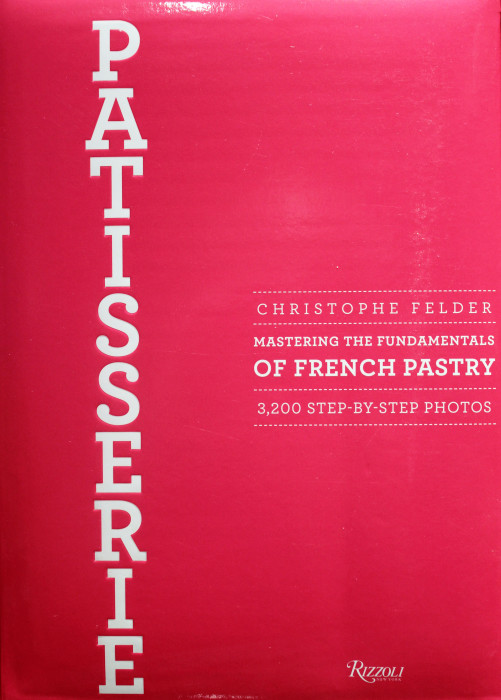This is Pastry Week on the blog and this is the fifth important pastry book being reviewed. For the last of the group, I have saved the biggest. Patisserie: Mastering the Fundamentals of French Pastry by Christophe Felder is a massive 800 pages anointed with 3,200 step-by-step photos leading you to the creation of 200 dessert treasures.
This is a pastry book unlike any other I have seen. Author Christophe Felder was a pastry master by his early 20’s. An Alsatian by birth, Felder comes from a family of bakers steeped in regional tradition. Felder followed the typical career of pastry school and apprenticing as one of the best and brightest in France. Now the author of over 20 books, he consults, teaches, and inspires.
This huge book is a compilation of several earlier ones, but merged here with a design that reflects his approach to teaching. As with any great pastry chef, he believes strongly in technique and precision. This book is his creative take on how to literally show the technique and detail needed in a perfect dessert. To succeed in this teaching, he has a little trick for drumming the instructions into your head.
Here’s how a typical recipe works. There are no header notes. It’s assumed you know the importance of, say, chocolate mousse. There is a simple quarter page picture of the final product, the list of ingredients and a rather terse list of one-or-two sentence paragraphs of instruction. This is not a wordy book.
But, here’s the twist, there is a set of photos for each step in the recipe, often more steps than in that first description. Underneath each photo, those earlier sentences are repeated, often in revised language and with a little more detail and much greater context because now you “see” what is happening at this very stage of creation. A recipe may have from 10 to nearly 30 of these small pictures providing a most complete sequence of steps for the entire dish.
It might be difficult to create a dish from those first terse instructions Felder provides. You need to “see” the recipe. You need the photos and their text, which both repeat and amplify the details. You have seen other cookbooks attempt this before, but this book is unique in its scale, quality and precision. There are 3,200 photos here and every one of them has a role to play in its own particular recipe.
There are no chapters in Patisserie on background, ingredients or technique. You jump right in and flour and butter are immediately put to work. The recipes are divided about equally among these chapters:
- Basis Pastry and Tarts
- Creams, Custards, and Puddings
- Decorations
- Classic Cakes and Desserts
- Chocolate Cakes and Candies
- Holiday Cakes, Cookies and Other Sweet Treats
- Macarons
- Brioches and Breakfast Pastries
- Petits Fours
In a book that talks about mastering the fundamentals, the recipes naturally include the basic staples, although this book does give you a richer abundance of doughs and crèmes than any other of the pastry books I have reviewed this week.
And there are recipes here that you won’t find in a typical pastry book. You’ll find the details to make Candied Rose Petals, Apple and Strawberry Chips, Chocolate Leaves, Sugar Sculptures, Caramel Flowers, and roses made from Pulled Sugar — perhaps the most intense recipe in the book.
Searching for a “different” brownie? Try one with hazelnut and coffee in the dough, baked, and then glazed with a combination of bittersweet chocolate and hazelnut cream.
Looking for something special to end a holiday meal? Consider Frozen Honey Parfait with Caramelized Pears or Baked Meringue with Chestnut Cream and Cherries.
It is impossible to page through this book and fail to be inspired, enticed, and maybe even bedazzled. With his rich experience in writing and teaching, you know that these recipes have been executed by thousands of his pastry students over the past decade. Every step needed to create each dish is now perfectly understood. Why, every step has even been photographed and now printed in this pastry tome.
Patisserie is book of substance, dedication, and — most of all love — for the kitchen and the wonders that it can produce. As Felder says in his introduction: the pleasure of a fine pastry lingers forever. You should linger over Patisserie.

